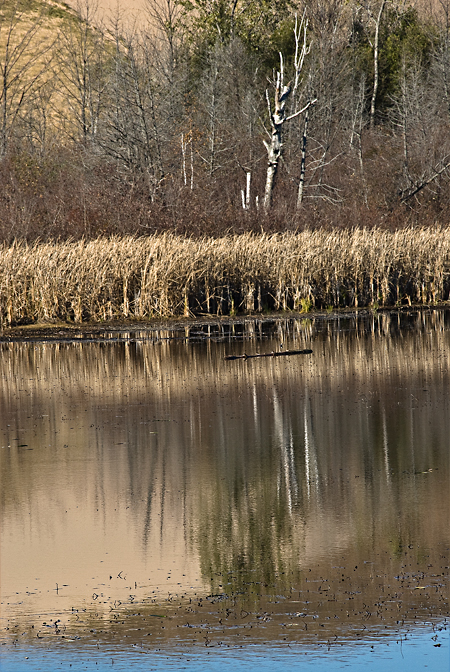Wedded to watery motifs, fond of reflection, and taking advantage of a brilliant, calm day in the dunes of Northern Michigan, motifs as the following were collected:
a more comprehensive view:
another close-up:
Bringing out the edges?
As a ‘sharpening’ freak, conditioned by microscopy in my day job, I reflexively ‘smart sharpen’ or ‘unsharp mask’ my images. Particularly, as my zoom lens with its very convenient range does not give the sharpest telephoto images.
A first attempt at general sharpening of the above images to accentuate the watery reflections produced an overly garish look. Therefore, I decided to selectively sharpen the mirroring to my heart’s content.
Two decades ago, during the time that I visited exhibitions of Richard Estes’ paintings with their cityscape reflections, I often scrutinized watery reflections of the hilly Long Island Northshore, wondering whether one could manage to capture them in a painterly photorealistic style.
How demanding would it be to portrait reflections as the ones above using oil painting?




Birgit,
When you figure out how to portray reflections in paint such as you’ve captured here as photo, tell me the secret(s). Or refer me to the book. I find it so beyond my abilities at the moment that I almost never try. Well, almost. Sometimes the city structures get caught in the river. But there I can fudge a lot — moving water, some distance between subject and reflection…..
I like the first photo best, I think, but the composition, that lovely “s” shape of the third is delicious. I kept looking to see if I could suss out anything about the color of the shadows, but had no luck.
Birgit,
I tend to like reflections better than the direct image. Your first here is particularly good upside down. Viewing the reflection tells you about the grasses and also about the water itself and the breeze over it–I thinks it’s these multiple layers I find intriguing.
It seems blasphemous for a photographer, and it may be more provocative than true, but I find I’m appreciating interesting ways to lose “information,” rather than keep maximum sharpness / information.
Guys:
Does anyone remember a now-deceased individual who gave painting demonstrations on tv? The person had a stock repertoire of old shacks, twiggy trees and various scenic effects that he applied with an almost pornographic enthusiasm. He was fun to watch.
One of his tricks was to drag a big wide brush across a painted area to smear out the details, thus giving an effect that would come across as watery reflections. A German artist whose name I don’t recall has used that technique on a large scale in many of his paintings.
Gerhard Richter.
D.
That’s the man.
Hi,
The water is good in the first image.
Before even trying reflections, I will attempt to figure out how I like to paint ‘just’ water. Crisp or smeared or whatever.
The Richard Schmid book arrived. I am pleased that some of the general hints in the early chapter agree with how I did my very first painting. I am looking forward to learning more about edges, values and colors.
I am fortunate in having two ‘role models’ at home. One is a still life by Hanneke van Oosterhout’s of her earlier theme not shown on her current website: A single rose standing in a body of water. Her yellow rose has delicious edges and, likewise, the water is delicately painted. The other one is a Haquette, a woman standing on wooden pier looking over the ocean.
Birgit,
I wonder if water might not be somewhat easier than it seems it would be. Perhaps we are (or at least I am) accepting of many ways of rendering it, since it’s so protean in reality. At any rate, with practice, I don’t doubt you can do better than the Botticelli in the following post.
Steve,
I welcome the clarity of air in the Botticelli picture.
Last night I read in R. S. that he, and, supposedly, Peter Sargent as well, had a hard time with the clarity of the air in the Rockies that made distant mountains look so close-by. Troels often talks about the immense clarity of air in Alaska. One reason to go there!
Since the industrial revolution, it seems to be the fashion to paint air pollution into landscapes. Perhaps, I will do a post on that theme.